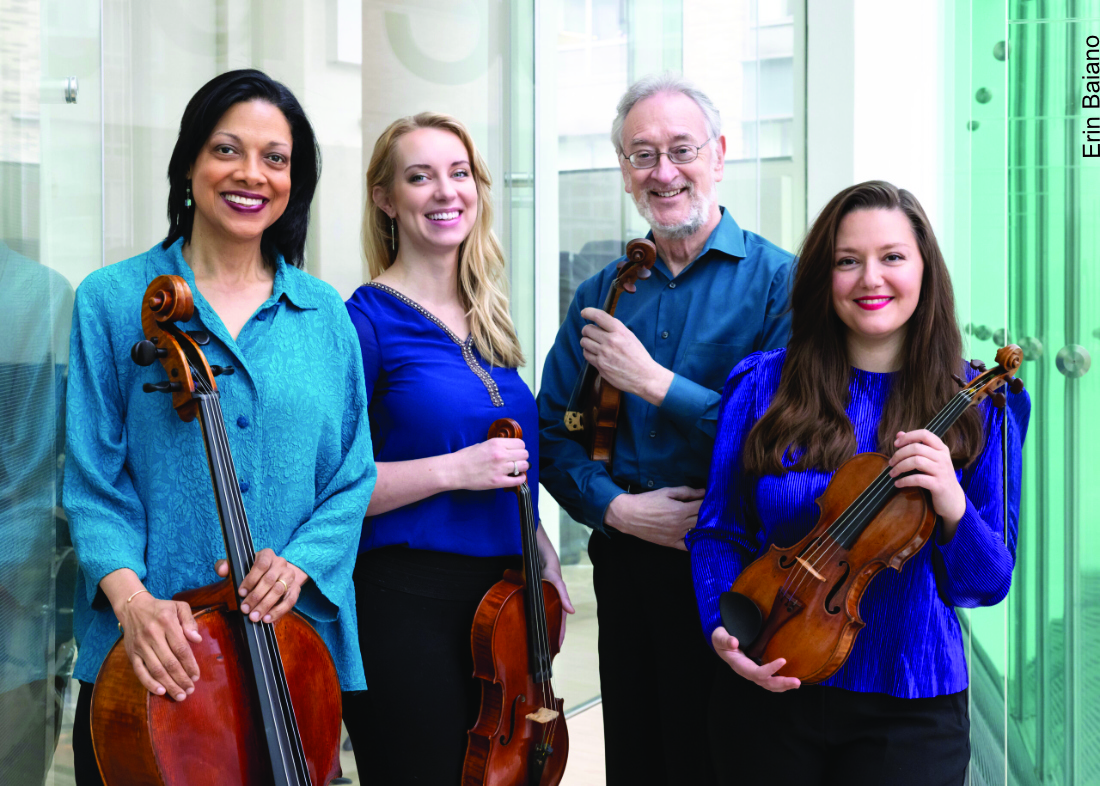Hailed by The Boston Globe as “the most important American quartet in history,” the Juilliard String Quartet draws on a deep and vital engagement to the classics, while embracing the mission of championing new works, resulting in a vibrant combination of the familiar and the daring. Their performances bring together the four members’ profound understanding, total commitment, and unceasing curiosity in sharing the wonders of string quartet literature.
This marks their fifth performance in our series. Their program includes a new piece by Tyson Davis, String Quartet No. 2 Amorphous Figures, co-commissioned by us, in addition to works by Beethoven and Schubert.
This concert is generously sponsored by Dr. Michael McGarvey.
L. van Beethoven (1770-1827): String Quartet No. 16 in F major, Op. 135
Allegretto
Vivace
Lento assai, cantate e tranquillo
Der schwer gefasste Entschluss (Grave – Allegro – Grave ma non troppo tanto – Allegro)
Tyson Davis (b. 2000): String Quartet No. 2, Amorphous Figures (2022)
co-commissioned by the Howland Chamber Music Circle
– intermission –
Franz Schubert (1797-1828): String Quartet No. 15 in G major, D. 887
Allegro molto moderato
Andante un poco moto
Scherzo. Allegro vivace – Trio. Allegretto
Allegro assai
Program notes by Joseph Gusmano
String Quartet No. 16 in F major, Op. 135 Ludwig Beethoven (1770-1827)
- Allegretto
- Vivace
- Lento assai, cantate e tranquillo
- Der schwer gefasste Entschluss (Grave – Allegro – Grave ma non troppo tanto – Allegro)
Completed in October of 1826, Beethoven’s String Quartet in F Major, Op. 135 was the composer’s last complete opus before taking his last breath in March of 1827. Eclipsing the breadth of even Haydn and Mozart, Beethoven’s final quartet became part of the greatest cycle of string quartets in history. That said, he had considerable trouble in finishing his last work, writing to his publisher Moritz Schlesinger,
Here, my dear friend, is my last quartet. It will be the last; and indeed it has given me much trouble. For I could not bring myself to compose the last movement. But as your letters were reminding me of it, in the end I decided to compose it. And that is the reason why I have written the motto “The decision taken with difficulty – Must it be? – It must be, it must be!
The quartet is full of potent music, rich with counterpoint. Beethoven demonstrates a mastery of string textures and techniques. The first two movements are in F major and feature bright energetic musical gestures, while the third movement introduces a slower, more contemplative theme. The heading of the final movement translates to “The Difficult Decision.” Above the slow introductory chords Beethoven inscribes, “Must it be?” Answering his own question, he writes “It must be!” above the faster principal theme of the movement.
String Quartet No. 2, Amorphous Figures …….………………. Tyson Davis (b. 2000)
Tyson Gholston Davis is an American composer in his senior year at The Juilliard School. Davis is the recipient of the Jerome L. Greene Fellowship and studies under Robert Beaser. He attended the University of North Carolina School of the Arts when he was a senior in high school and has already been the recipient of over 22 commissions. One such commission, Delicate Tension, for the National Youth Orchestra of the United States of America was commissioned by the American Embassy in Berlin in honor of the 30th anniversary of the fall of the Berlin Wall.
Amorphous Figures is Davis’ second published piece for string quartet. The quartet was co-commissioned by Howland Chamber Music Circle, Da Camera Society of Houston, The John F. Kennedy Center for the Performing Arts, and Chamber Music Cincinnati for the Juilliard Quartet. Davis cites Helen Frankenthaler’s abstract expressionist painting, Jacob’s Ladder (1957). The contrasting musical themes in this work swirl around one another, finally blending into one single figure, as do the various colors in Frankenthaler’s work. To translate this visual work into his aural one, Davis used a graphic score to map out certain sections of the piece.
– intermission –
String Quartet No. 15 in G major, D. 887 ………………………. Franz Schubert (1797-1828)
- Allegro molto moderato
- Andante un poco moto
- Scherzo. Allegro vivace – Trio. Allegretto
- Allegro assai
Franz Schubert is best known for his vast body of work, with over 400 piano works and nearly 600 vocal works. This prolific output is even more impressive considering Schubert experienced very little commercial or professional success during his short life. In addition to his steadfast friends and supporters, Schubert garnered the interest of such musical giants as Mendelssohn, Liszt, Schumann, and Brahms. His compositional prowess also extended into the world of chamber and orchestral music, with his string writing as subtle and lush as his piano and vocal works.
Schubert’s fifteenth and final quartet explores more distantly related key areas. He uses pizzicato, or plucked strings, and extreme contrasts in dynamics to emphasize transitions to new harmonic landscapes. The first movement of the piece features pizzicato as an accompanying figure beneath a lyrical melody that moves throughout all four strings. The following slow movement features glissandi, or sliding along the fingerboard, in the violins as well as tremolo, or rapid consecutive bowing until the gesture becomes more texture than rhythm. The third movement reintroduces themes from the second movement, both of which are performed by the cellist. The final movement has no clearly-defined formal structure, and the rhythms are reminiscent of a tarantella, an Italian folk dance that was thought to cure the bite of a poisonous spider.
Juilliard String Quartet
With unparalleled artistry and enduring vigor, the Juilliard String Quartet continues to inspire audiences around the world. Founded in 1946 and hailed by The Boston Globe as “the most important American quartet in history,” the ensemble draws on a deep and vital engagement to the classics, while embracing the mission of championing new works, a vibrant combination of the familiar and the daring. Each performance of the Juilliard String Quartet is a unique experience, bringing together the four members’ profound understanding, total commitment, and unceasing curiosity in sharing the wonders of the string quartet literature.
In 2023, the Juilliard String Quartet welcomes violist Molly Carr, and also performs world premieres, including two works written for the group by celebrated German composer, Jörg Widmann, composed to be performed alongside late quartets by Beethoven which they premiered at the Arizona Friends of Chamber Music. The JSQ also premieres rising American composer Tyson Davis’ String Quartet No. 2 — commissioned by the Kennedy Center, the DaCamera Society of Houston, Chamber Music Cincinnati, and the Howland Chamber Music Circle. Other season highlights include tours with violinist Itzhak Perlman and pianist Jean-Yves Thibaudet, performing Chausson Concert for Violin, Piano and String Quartet, culminating in a concert at Carnegie Hall; two European tours including stops in Italy, Germany, Austria, and the Czech Republic; and concerts in Philadelphia, Detroit, San Francisco, Seattle, Vancouver, and Napa Valley.
Adding to its celebrated discography, the JSQ recorded an album of works by Beethoven, Bartók, and Dvořák which was released by Sony Classical in April 2021 to critical acclaim. Additionally, Sony Masterworks released JSQ’s The Early Juilliard Recordings in June 2021. In the fall of 2018, the JSQ released an album on Sony featuring the world premiere recording of Mario Davidovsky’s Fragments (2016), together with Beethoven’s Quartet Op. 95 and Bartók’s Quartet No. 1. Additionally, Sony Classical’s 2014 reissue of the Quartet’s landmark recordings of the first four Elliott Carter String Quartets along with the 2013 recording of Carter’s fifth quartet traces a remarkable period in the evolution of both the composer and the ensemble. The Quartet’s recordings of the Bartók and Schoenberg Quartets, as well as those of Debussy, Ravel and Beethoven, have won GRAMMY Awards, and in 2011, the JSQ became the first classical music ensemble to receive a lifetime achievement award from the National Academy of Recording Arts and Sciences.
Devoted master teachers, the members of the Juilliard String Quartet offer classes and open rehearsals when on tour. The JSQ is String Quartet in Residence at the Juilliard School and its members — Areta Zhulla, Ronald Copes, Molly Carr, and Astrid Schween — are all sought-after teachers on the string and chamber music faculties. Each May, they host the five-day internationally recognized Juilliard String Quartet Seminar. During the summer, the JSQ works closely on string quartet repertoire with students at the Tanglewood Music Center.
Tyson Davis (b.2000)
Tyson Gholston Davis (b. 2000) is an American composer in his senior year at The Juilliard School where he is a recipient of the Jerome L. Greene Fellowship studying with Robert Beaser. Davis began composing at the age of eight years old and entered the University North Carolina School of the Arts (UNCSA) as a high school freshman, studying with Lawrence Dillon. In the summer of 2019, Davis worked with the National Youth Orchestra of the United States of America (NYO-USA) and Antonio Pappano to premiere his work, Delicate Tension, a piece that was commissioned by the American Embassy in Berlin for the 30th Anniversary of the fall of the Berlin Wall. The work was performed in Berlin, Edinburgh, and Hamburg.
Since then, Davis has been a leading desired composer to be performed and commissioned by leading ensembles. He has been the recipient of more than 22 commissions by organizations such as The Juilliard String Quartet, the Albany Symphony, The Saint Paul Chamber Orchestra, Eighth Blackbird, WQXR, New York New Music Ensemble, and the Metropolis Ensemble.
His recently finished work, Amorphous Figures (String Quartet No. 2) was commissioned by the Howland Chamber Music Circle, Da Camera Society of Houston, The John F. Kennedy Center for the Performing Arts, and Chamber Music Cincinnati for the Juilliard String Quartet. Currently, Davis is backed up with commissions until mid-2024 with works for soprano saxophone and piano (for Robert Young), wind quintet (for Zéphyros Winds), solo piano (Jonathan Biss), and several others.
Tyson’s favorite classical composers include Beethoven, Elliott Carter, Henri Dutilleux, Unsuk Chin, George Benjamin, and Jacob Druckman. He also loves the pop music of Marvin Gaye, John Denver, Simon and Garfunkel, and many others. He lives in Washington Heights, NYC, and enjoys frequent walks in Fort Tryon Park.





